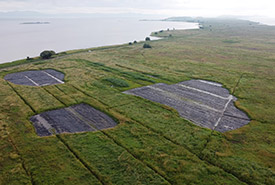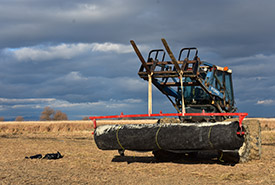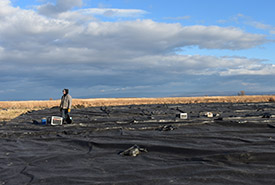Île aux Grues - Fighting phragmites

Tarps covering phragmites colonies in the upper marshes of Île aux Grues (Photo by DanielTphoto)
Located in the heart of the St. Lawrence River, about 80 kilometres east of Quebec lies Île aux Grues. It is recognized as a high biodiversity site in Quebec — over 200 bird species nest or stop to refuel here during migration. Île aux Grues is connected to the neighbouring Île aux Oies by a tidal flat known as the upper marshes. The many bird species that frequent the area include bobolink (an at-risk species in Canada) and short-eared owl (a species of special concern in Canada and likely to be designated at-risk or vulnerable in Quebec).
NCC protects 170 hectares on Île aux Grues, including the Jean-Paul-Riopelle Nature Reserve at Pointe aux Pins. Even though this land is protected, it is still vulnerable to certain threats. There is a marked presence of phragmites, an invasive species, in the upper marshes. Also known as common reed, this plant, which was introduced from Europe and Asia, degrades the quality of wetlands by depriving wildlife of their habitats and driving out native plant species. Phragmites harms biodiversity in the areas it colonizes by rapidly out-crowding other species, preventing them from growing.
A colossal task
It was essential to take action, because this formidable invader was posing a threat to numerous local plant and animal species. After an initial series of trials carried out between 2015 and 2017 on the upper marsh properties, and in light of results obtained by other property owners trying to limit the damage caused by this invasive species, in 2019, NCC launched a wide-scale project aimed at controlling phragmites in this area.

The team installs the tarps with the help of a tractor (Photo by NCC)
The first stage of this project was completed in the fall of 2020. We applied both tarping and mowing to maximize our chances of success. We used local expertise as much as possible by forming partnerships with companies and suppliers in the region — an effective way to foster ties with the community! After mowing all of the targeted colonies, we and our partners covered all the surfaces with large tarps, which will be left in place for several years. It was a major job for our dedicated team!
Challenges and victories
This project is not without its challenges. Because of flooding caused by the river’s high tides, the upper marshes are only accessible for limited periods of time. Given the fragility of this ecosystem, the team had to take measures to minimize the impact of machinery on nesting birds and the ground. That’s why we chose the fall as the ideal period to complete the work. But the team faced additional challenges such as wind and freezing temperatures, which made it trickier to install the immense tarps. Fall is also hunting season for migratory birds, which is a very popular activity in the region.

A team member examines a tarp (Photo by NCC)
This tireless work was carried out over two years, covering a total surface of two hectares. Once the installation is complete, monitoring and regular maintenance are planned for the coming years. We also mowed two hectares of colonies, for a control project totalling 4 hectares. When we remove the tarps in 2025, we’ll revegetate the area with native species to restore the upper marshes’ rich biodiversity.
Want to learn more about this project? Read the detailed version of this article here!
Participating partners







This project benefitted from funds provided by the Government of Canada through the Habitat Stewardship Program and the Priority Places program, part of Canada’s Nature Fund, as well as funds provided by the Quebec Government to Fondation de la faune du Québec for its Program for the battle against invasive exotic plants and to NCC’s Projet de partenariat pour les milieux naturels, for which NCC received more than $53M in support from the Quebec government.




